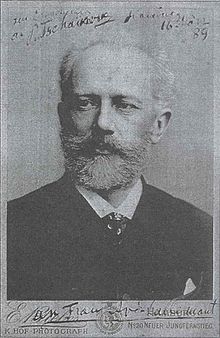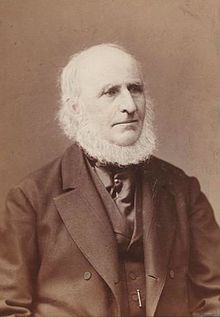Theodor Avé-Lallemant
Johann Theodor Friedrich Avé-Lallemant (born February 2, 1806 in Magdeburg , † November 9, 1890 in Hamburg ) was a German music teacher, music critic and music writer.
biography
Family background

in Hamburg in 1888
Avé-Lallemant was the son of the music teacher Johann Heinrich Jacob Dionysius Avé-Lallemant (1776-1852) and his wife Friederike Marie Canier (1783-1857), Huguenot and descendant of Admiral Gaspard II. De Coligny, seigneur de Châtillon (1519-72 ) (10 children, 6 sons 4 daughters). His uncle was the pianist and cathedral organist Friedrich Avé-Lallemant (1774-1853), who had already made music with Louis Ferdinand of Prussia .
The doctor and South America researcher Robert Christian Avé-Lallemant , the criminalist and writer Friedrich Christian Benedikt Avé-Lallemant and the pastor Friedrich Avé-Lallemant were his brothers. He had been married to Wilhelmine Jauch since 1840 , with whom he had six children. The son Carl Robert (1850-1896), who led the relief expedition for the earthquake area Tovar (Mérida) in Venezuela in 1894 , was the godchild of Robert Schumann , the son Johannes Friedrich Bernhard (1855-1911) was the godchild of Johannes Brahms . The daughter Emilie Elisabeth (1846–1921) married the underwriter Paul Clemens Duncker (1840–1909), grandson of Johann Georg Kerner , great-nephew of Justinus Kerner and second cousin of Wilhelm Hauff .
Education and early years
Avé-Lallemant began taking music lessons in 1815. From 1824 he was instructed in Greifswald by the local town musician. In Lübeck he became acquainted with the painters Otto and Erwin Speckter , from whom Otto introduced him to the houses of the Lübeck Syndicus Curtius and the consul Christian Adolf Nölting . In 1828 he responded to the urge to move to Hamburg. There he stayed at the house of the art-loving citizen Johann Christian Jauch senior and met his wife, his daughter, there.
Work in Hamburg
Avé-Lallemant had been a member since 1838, subsequently becoming the first chairman of the committee for the Philharmonic Concerts, and was at the center of the musical endeavors there “for longer than a human life” (Berthold Litzmann). Previously active as a music teacher and music writer - he described himself as a "Tonkünstler" and "Musikant" - his marriage to the wealthy Wilhelmine Jauch allowed him to dedicate himself from 1840 to the good of Hamburg's musical life. In 1841 he was the central figure at the third North German Music Festival, at that time the largest music festival in Germany. In 1847 he was one of the co-founders of the Hamburg Tonkünstlerverein. When he died in 1890, he was the oldest member of the committee, to which he had belonged for 52 years, and which commemorated him in a ceremony in the Philharmonic.
Avé-Lallemant was a friend of Johannes Brahms and Robert Schumann . In 1862/63 Avé-Lallemant failed with his attempt to get Brahms to become director of the Philharmonic Concerts, or at least to get Brahms to be the choir master of the Singakademie. Although Brahms had never openly applied for these positions, he was deeply hurt that Julius Stockhausen had been chosen over him. In 1863 Brahms left Hamburg and accepted the offer to become choirmaster of the Vienna Singing Academy. The process put a strain on the friendly relationship with Avé-Lallemant for years. Pyotr Tchaikovsky met Avé-Lallemant in 1888. Tchaikovsky dedicated his major symphonic work, the Fifth Symphony in E minor , which he performed in Hamburg on March 15, 1889 . Hans von Bülow dedicated his Chant polonais Opus 12 to him in 1860 .
Third North German Music Festival
Concert in the Michaeliskirche
Tivolifest St. Georg
estate
With the help of the Kulturstiftung der Länder, the Brahms Institute at the Lübeck University of Music acquired numerous musical manuscripts by important composers and letters from Theodor Avé-Lallemant from the Avé-Lallemant family archive for its autograph collection.
The Hamburg State and University Library acquired further manuscripts and printed music from parts of the family's estate in 2010 , including letters from Brahms, Clara and Robert Schumann , Joseph Joachim and Tschaikowsky as well as a fragmentary part of the hitherto unknown autograph of Brahms' Wechsellied zum Tanze ( op. 31, 1).
Quotes
“In Hamburg I made some interesting and pleasant acquaintances again. Above all, I would like to mention the first chairman of the Philharmonic Society, the very old Mr. Avé-Lallemant. The venerable old man over eighty showed me an almost paternal affection. ... I insisted on visiting this good old man several times. One noticed immediately that he loves music passionately and is completely free of the aversion to everything modern that can often be observed in old people. "
“You sat at small tables; Tchaikovsky had the place of honor next to a distinguished old man, Mr. Ave-Lallemant, the first chairman of the society. He liked the tender old man extraordinarily well; ... "
"At table with Lallemant, who has a very pleasant educated wife ..."
literature
- Benedikt Avé-Lallemant: Review of the Third North German Music Festival in Hamburg. Lübeck 1841.
- Theodor Avé-Lallemant: Recollections of an old musician. printed as a manuscript. Hamburg 1878.
- Peter Avé-Lallemant (ed.): Chronicle of the Avé-Lallemant family. Compiled by Hans Avé-Lallemant. Typoscript in 30 copies 1948.
- Peter Feddersen: Tchaikovsky in Hamburg. A documentation. (= Cajkovskij studies. Volume 8). Mainz 2006 (inter alia, p. 256 portrait of Theodor Avé-Lallemant and Mrs. Wilhelmine nee Jauch, p. 257 portrait of Peter Tschaikowsky from 1888 with dedication “to Mrs. Avé-Lallemant”)
- Charles Fuchs (Ed.): Memories of the third North German Music Festival in Hamburg in July 1841. Hamburg 1841.
- Kurt Hofmann: Theodor Avé-Lallemant. In: Bernhard R. Appel (Ed.): Music manuscripts and letters from the Avé-Lallemant family archive. (= Patrimonia. 197). (Ed. By the Kulturstiftung der Länder in conjunction with the) Brahms Institute at the Lübeck University of Music, Berlin 2001.
- Kurt Hofmann: Johannes Brahms in Hamburg. Reinbek 1986.
- Michael Struck: Manuscripts with question marks and exclamation marks. The works from the Avé-Lallemant family archive ascribed to Clara Wieck. In: Bernhard R. Appel (Ed.): Music manuscripts and letters from the Avé-Lallemant family archive. (= Patrimonia. 197). (Ed. By the Kulturstiftung der Länder in conjunction with the) Brahms Institute at the Lübeck University of Music, Berlin 2001.
- Conrad Nikolaus Lührsen: The Avé-Lallemant family and their descendants. In: German Family Archives. (DFA) Volume 23, Neustadt an der Aisch 1963, pp. 205-243.
See also:
- Luise Avé-Lallemant: The musical album sheets of Luise Avé-Lallemant in Leipzig . A collection of autographs from the Leipzig University Library. Facsimile edition on the occasion of the opening of the new Gewandhaus in 1981 with a foreword by Kurt Masur. Edition Leipzig, Leipzig 1981. (Bibliophile edition with facsimile original articles by CF Becker, F. David, HW Ernst, R. Franz, NW Gade , M. Hauptmann, AF Hesse, F. Hiller, T. Kullak, F. Mendelssohn Bartholdy, I. Moscheles, C. Reinecke, JCF Schneider, Robert and Clara Schumann and others)
swell
- ^ Johann Hennings, Wilhelm Stahl: Lübeck's music history. 1951, p. 142.
- ↑ See Kurt Hofmann: Brahms in Hamburg, new knowledge on an old topic. Reinbek, n.J. (1986). The Philharmonic Society, which has existed since 1828, an exclusively private association that has worked with the Hamburger Singakademie from the start, was looking for its director, Friedr, to work for 34 years. Wilh. Reason for a successor. “The most important factor here was personality, because the actual type of conductor was only later shaped by Hans von Bülow. It was obvious that Hamburg could not be willing to take risks. After all, it was not about talent, but about securing the financial security of the Philharmonic concerts. Artistic experiments were not considered. ”(P. 34) Brahms' friend and supporter Theodor Avé-Lallement planned in early 1862 to initially create the post of director of the Singakademie for Brahms in order to gradually influence the declining quality of the Philharmonic To procure works and to give reason to resign from office earlier (p. 32). What was needed was a personality that possessed integration and attraction for the audience and the musicians. “These qualities were embodied by Julius Stockhausen, not Johannes Brahms.” (P. 35) “Brahms was not able to integrate at this time and was also not popular with musicians.” (36) - quoted from: Klaus Mühlfried: Architecture as an expression of political sentiment - Martin Haller and his work in Hamburg. Hamburg 2005, p. 83f, footnote 345
- ↑ Hans-Joachim Hinrichsen: Musical interpretation. Hans von Bülow (= Archive for Musicology . Supplement 46). Stuttgart undated, p. 374.
- ↑ Stabi wings: Presentation of new acquisitions for the Brahms archive (January 14 , 2011 ) , accessed on January 12, 2011.
- ^ Memories, pp. 412f.
- ^ Symphonie Pathétique , 1935.
- ^ Robert Schumann: Diaries. Volume II, ed. by Gerd Nauhaus, Leipzig 1987, p. 210.
Web links
| personal data | |
|---|---|
| SURNAME | Avé-Lallemant, Theodor |
| ALTERNATIVE NAMES | Avé-Lallemant, Johann Theodor Friedrich |
| BRIEF DESCRIPTION | German music critic and music writer |
| DATE OF BIRTH | February 2, 1806 |
| PLACE OF BIRTH | Magdeburg |
| DATE OF DEATH | November 9, 1890 |
| Place of death | Hamburg |







